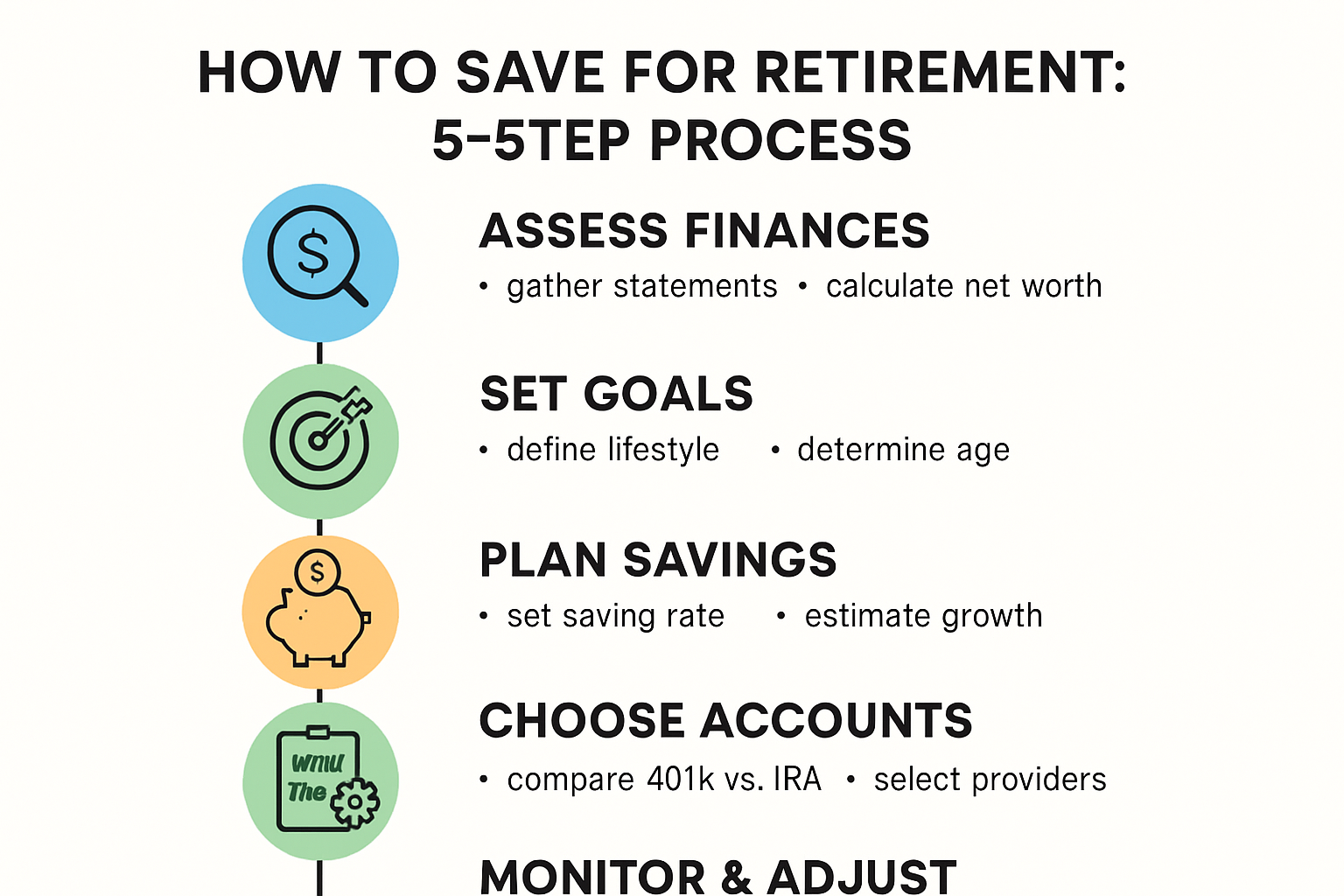Retirement planning sounds like a huge mountain to climb. Most people think building a secure future means sacrificing every extra dollar today. But studies show you might need only 70-80 percent of your pre-retirement income to enjoy your golden years. That’s a lot less than most people expect and it changes everything about how you get started.
Table of Contents

- Step 1: Assess Your Current Financial Situation
- Step 2: Define Your Retirement Goals And Needs
- Step 3: Create A Customized Savings Plan
- Step 4: Choose The Right Retirement Accounts
- Step 5: Monitor And Adjust Your Savings Regularly
Quick Summary
| Key Point | Explanation |
|---|---|
| 1. Gather and assess financial documents | Collect bank statements, retirement accounts, and debt records to calculate your net worth. |
| 2. Define your retirement lifestyle | Envision your ideal retirement and estimate annual expenses to align your financial planning. |
| 3. Customize your savings plan | Establish a realistic savings rate and set up automatic contributions to retirement accounts. |
| 4. Choose suitable retirement accounts | Evaluate 401(k), IRAs, and other accounts based on tax benefits and your financial situation. |
| 5. Regularly monitor and adjust savings | Schedule biannual reviews to track progress and adapt your strategy to life changes. |
Step 1: Assess Your Current Financial Situation
Understanding your current financial landscape is the critical foundation for effective retirement planning. This initial step transforms abstract retirement dreams into a concrete, actionable strategy by providing a comprehensive snapshot of your financial health.
Begin by gathering all financial documents, including bank statements, investment accounts, retirement plan records, and debt statements. Create a detailed spreadsheet or use a financial tracking app to consolidate your financial information. Your goal is to calculate your net worth by tallying all assets and subtracting existing liabilities.
Assets include everything you own with monetary value: savings accounts, retirement accounts, real estate, vehicles, investments, and personal property. Liabilities encompass all outstanding debts such as mortgages, credit card balances, student loans, and personal loans. By meticulously documenting these items, you create a clear financial baseline.
According to the U.S. Department of Labor, calculating your net worth helps you understand your current financial position and identifies potential gaps in your retirement strategy. Pay special attention to your existing retirement accounts, including 401(k), IRA, and any employer-sponsored plans.
Next, analyze your monthly income and expenses. Track every expenditure for at least three months to understand your spending patterns. Categorize expenses into essential and discretionary spending. This exercise reveals potential areas for savings and helps you determine how much you can realistically allocate toward retirement.
Key verification points for completing this step include:
- A comprehensive spreadsheet listing all financial assets and liabilities
- Accurate calculation of your current net worth
- Clear understanding of monthly income versus expenses
- Identification of potential areas for financial optimization
Remember, this assessment is not about judgment but about creating a transparent financial roadmap. The more accurate and honest you are during this process, the more effective your retirement planning will become. Your current financial situation is simply a starting point from which you can build a robust, personalized retirement strategy.
Here is a helpful checklist to verify you have completed all recommended actions for Step 1: Assess Your Current Financial Situation.
| Verification Item | Description |
|---|---|
| Gather financial documents | Collect bank statements, retirement and investment account records, and debt statements |
| List assets and liabilities | Document all assets (savings, real estate, investments) and all debts (mortgages, loans, credit cards) |
| Calculate net worth | Subtract total liabilities from total assets |
| Analyze income and expenses | Track monthly income and categorize expenses over at least three months |
| Identify areas to optimize | Spot opportunities to reduce spending or increase retirement allocations |
Step 2: Define Your Retirement Goals and Needs
Defining your retirement goals transforms abstract dreams into a structured financial blueprint. This critical step bridges the gap between your current financial situation and your future lifestyle aspirations, requiring deep personal reflection and strategic planning.
Start by envisioning your ideal retirement experience. Close your eyes and imagine your daily life after leaving the workforce. Will you travel extensively? Pursue hobbies? Spend time with family? Relocate to a different region? Each of these choices carries significant financial implications. Realistic goal setting means balancing your dreams with financial practicality.
Calculate your anticipated annual retirement expenses by considering current lifestyle costs and potential changes. Most financial experts suggest planning for 70-80% of your pre-retirement income. However, this percentage can fluctuate based on individual circumstances. Some retirees might spend more initially on travel and leisure, while others may have reduced expenses due to paid-off mortgages or simplified living.
According to the U.S. Department of Labor, developing a comprehensive retirement budget requires careful consideration of multiple factors including healthcare costs, potential long-term care needs, and inflation adjustments.
Factor in potential income streams beyond personal savings. Social Security benefits, pension plans, rental income, or part-time work can supplement your retirement funds. Understanding these potential revenue sources helps you more accurately determine how much additional savings you’ll need.
Key verification points for completing this step include:
- A detailed written description of your retirement lifestyle vision
- Estimated annual retirement expenses accounting for potential lifestyle changes
- Calculation of expected income from various sources
- Preliminary gap analysis between anticipated expenses and projected income
Remember that retirement goal setting is not a one-time event but an ongoing process. Your objectives will evolve with changing personal circumstances, economic conditions, and life experiences. Approach this step with flexibility and a commitment to periodic reassessment, ensuring your retirement plan remains dynamic and responsive to your evolving needs.
Step 3: Create a Customized Savings Plan
Creating a customized savings plan transforms your retirement goals from theoretical concepts into a practical, actionable strategy. This step is about designing a targeted approach that aligns your financial capabilities with your long-term retirement objectives.
Begin by establishing a realistic savings rate based on your current income and expenses. Financial experts often recommend saving 10-15% of your gross income for retirement, but this percentage can vary depending on your age, current financial status, and retirement timeline. If you are starting later or have ambitious retirement goals, you might need to save a higher percentage.
Maximize tax-advantaged retirement accounts as the cornerstone of your savings strategy. 401(k) plans with employer matching represent an immediate opportunity to boost your savings. Contribute at least enough to receive the full employer match, which is essentially free money. Individual Retirement Accounts (IRAs) offer additional tax-efficient saving options, with traditional and Roth variations providing different tax benefits.
Consider implementing an automated savings approach to ensure consistency. Set up automatic monthly transfers from your checking account to retirement accounts. This strategy removes the psychological barrier of manual saving and helps you treat retirement contributions as a non-negotiable expense. Many employers offer automatic payroll deductions directly into retirement accounts, which can simplify this process.
According to the U.S. Department of Labor, creating a personalized savings plan requires understanding your unique financial landscape and setting realistic, achievable milestones.
Diversify your investment portfolio to balance risk and potential returns. While younger investors can typically tolerate more aggressive investment strategies, those closer to retirement should gradually shift toward more conservative investments. Consider a mix of stocks, bonds, and other assets that align with your risk tolerance and retirement timeline.
Key verification points for completing this step include:
- Established monthly or quarterly automatic retirement contributions
- Clear documentation of targeted savings percentage
- Comprehensive review of available retirement account options
- Initial investment portfolio allocation aligned with personal risk profile
Remember that a customized savings plan is not static. Regularly review and adjust your strategy as your income grows, life circumstances change, and you progress toward your retirement goals. Flexibility and consistent monitoring are key to long-term financial success.
Step 4: Choose the Right Retirement Accounts
Choosing the right retirement accounts is a strategic decision that can significantly impact your long-term financial security. This step involves carefully selecting investment vehicles that align with your unique financial situation, tax considerations, and retirement goals.
Start by evaluating your workplace retirement options. Employer-sponsored 401(k) plans often represent the foundation of retirement savings, especially if your employer offers matching contributions. These accounts allow you to contribute pre-tax dollars, reducing your current taxable income while building retirement savings. If your employer provides a match, prioritize contributing enough to receive the full employer contribution – this is essentially free money that accelerates your retirement savings.
Consider supplementing workplace plans with Individual Retirement Accounts (IRAs). Traditional and Roth IRAs offer distinct tax advantages. Traditional IRAs provide an immediate tax deduction on contributions, with taxes paid upon withdrawal during retirement. Roth IRAs, conversely, use after-tax contributions but allow tax-free withdrawals during retirement. Your current income, age, and expected future tax bracket will help determine which option best suits your financial strategy.
For self-employed individuals or those without workplace retirement plans, alternative accounts like SEP IRAs or Solo 401(k) plans provide robust saving opportunities. These specialized accounts often allow higher contribution limits and more flexible investment options tailored to independent professionals.
According to the IRS, understanding the specific characteristics of each retirement account type is crucial for making informed investment decisions. Pay close attention to contribution limits, tax implications, and potential penalties for early withdrawals.
Consider your risk tolerance and investment timeline when selecting specific investment options within these accounts. Younger investors might lean toward more aggressive, stock-heavy portfolios, while those closer to retirement should gradually shift toward more conservative, balanced investments.
Selecting the right retirement account is crucial. The table below compares major account types based on source, tax advantages, and who can use them to help you choose the best fit for your needs.
| Account Type | Source | Tax Advantage | Eligibility/Notes |
|---|---|---|---|
| 401(k) | Employer | Pre-tax contributions, tax-deferred growth | Only with participating employers |
| Traditional IRA | Individual | Tax-deductible contributions, taxes owed at withdrawal | Anyone with earned income |
| Roth IRA | Individual | After-tax contributions, tax-free withdrawals | Income limits apply |
| SEP IRA | Self-employed | Tax-deductible, higher contribution limits | For self-employed, small business |
| Solo 401(k) | Self-employed | Pre-tax contributions, high limits | Only for self-employed/no employees |
Key verification points for completing this step include:
- Comprehensive review of all available retirement account options
- Confirmation of current employer matching contributions
- Clear understanding of tax implications for each account type
- Initial investment allocations aligned with personal financial goals
Remember that retirement account selection is not a one-time decision. Regularly review and rebalance your accounts, adjusting your strategy as your financial situation evolves and retirement approaches. Flexibility and continuous education are your greatest allies in building a robust retirement savings strategy.
Step 5: Monitor and Adjust Your Savings Regularly
Monitoring and adjusting your retirement savings is not a passive task but an active, ongoing process that ensures your financial strategy remains aligned with your evolving life circumstances. This critical step transforms your retirement plan from a static document into a dynamic, responsive financial roadmap.
Implement a systematic review process by scheduling comprehensive financial check-ups at least twice per year. These reviews should examine your investment performance, contribution rates, and overall progress toward your retirement goals. Look beyond simple account balances and analyze the broader performance of your investment portfolio, considering factors like asset allocation, investment returns, and how closely you are tracking your original savings targets.
Technological tools can significantly streamline this monitoring process. Utilize personal finance apps and online dashboards that aggregate your financial accounts, providing real-time insights into your retirement savings. Many of these platforms offer automatic performance tracking, investment analysis, and personalized recommendations that can help you make informed adjustments.
Pay close attention to life changes that might necessitate savings strategy modifications. Career transitions, marriage, having children, or experiencing significant income shifts are all moments that should trigger a comprehensive review of your retirement plan. These milestones often require recalibrating your savings rate, adjusting investment allocations, or updating your long-term financial projections.
According to the U.S. Department of Labor, successful retirement planning requires consistent monitoring and a willingness to adapt your strategy as your personal and financial landscape evolves.
Understand the importance of rebalancing your investment portfolio. Market fluctuations can cause your initial asset allocation to drift, potentially exposing you to more risk than intended. Periodic rebalancing helps maintain your desired risk level and can potentially improve long-term investment performance.
Key verification points for completing this step include:
- Established semi-annual financial review schedule
- Documented performance tracking of retirement accounts
- Recorded adjustments to savings strategy based on life changes
- Comprehensive understanding of current investment portfolio allocation
Remember that monitoring your retirement savings is not about achieving perfection but maintaining consistent progress. Approach these reviews with patience, objectivity, and a commitment to your long-term financial well-being. Small, strategic adjustments made consistently can significantly impact your retirement readiness.

Ready to Take Control of Your Retirement Journey?
You have just explored how to assess your finances, set concrete retirement goals, build a smart savings plan, select the right accounts, and regularly review your progress. But if you are feeling overwhelmed or uncertain about turning these steps into real-life action, you are not alone. Many readers face challenges like making sense of net worth calculations, fine-tuning savings strategies, and selecting the best retirement accounts. There is also the pressure of ensuring your plan evolves as your life and the market change. These decisions matter today, not tomorrow.
At finblog.com, we transform uncertainty into clarity. Get access to personalized strategies and guidance tailored to your exact situation. Our expert resources and secure interactive tools simplify complex topics such as investment allocation and automated savings. If you want more confidence and security in your retirement planning, take the next step now. Start by exploring our featured resources and connect with experienced advisors who understand the details discussed in this guide. Do not wait for the perfect moment. The best time to secure your future is right now. Visit finblog.com and move closer to the retirement you deserve.
Frequently Asked Questions
How can I assess my current financial situation for retirement planning?
To assess your financial situation, gather all financial documents, including bank statements, investment accounts, retirement plan records, and debt statements. Calculate your net worth by listing all assets and liabilities, and analyze your monthly income and expenses to identify areas for potential savings.
What are the essential steps to define my retirement goals?
Start by envisioning your ideal retirement lifestyle, such as travel, hobbies, or relocation. Calculate your anticipated annual retirement expenses, usually 70-80% of your pre-retirement income, and factor in potential income streams like Social Security or pensions for a comprehensive budget.
What should I consider when creating a customized savings plan for retirement?
Establish a realistic savings rate, typically 10-15% of your gross income, depending on your age and financial goals. Maximize contributions to tax-advantaged retirement accounts, automate your savings, and diversify your investment portfolio based on your risk tolerance and retirement timeline.
How often should I monitor and adjust my retirement savings plan?
You should review your retirement savings at least twice a year. This includes assessing investment performance, contribution rates, and making adjustments based on life changes, such as career transitions or income shifts, to ensure your strategy remains aligned with your goals.










